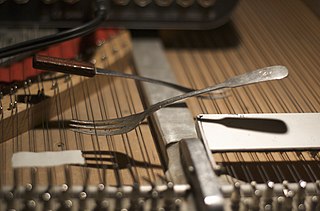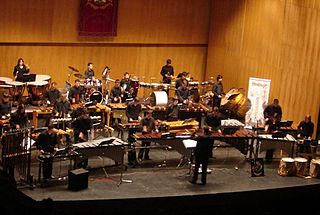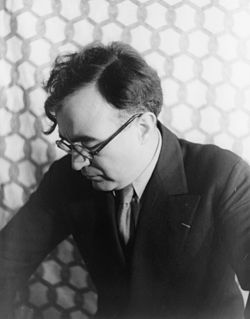
John Milton Cage Jr. was an American composer, music theorist, artist, and philosopher. A pioneer of indeterminacy in music, electroacoustic music, and non-standard use of musical instruments, Cage was one of the leading figures of the post-war avant-garde. Critics have lauded him as one of the most influential composers of the 20th century. He was also instrumental in the development of modern dance, mostly through his association with choreographer Merce Cunningham, who was also Cage's romantic partner for most of their lives.

A prepared piano is a piano that has had its sound altered by placing objects on or between the strings.

A percussion ensemble is a musical ensemble consisting of only percussion instruments. Although the term can be used to describe any such group, it commonly refers to groups of classically trained percussionists performing primarily classical music. In America, percussion ensembles are most commonly found at conservatories, though some professional groups, such as Nexus and So Percussion exist. Drumlines and groups who regularly meet for drum circles are two other forms of the percussion ensemble.

Timothy "Tim" George Hodgkinson is an English experimental music composer and performer, principally on reeds, lap steel guitar, and keyboards. He first became known as one of the core members of the British avant-rock group Henry Cow, which he formed with Fred Frith in 1968. After the demise of Henry Cow, he participated in numerous bands and projects, eventually concentrating on composing contemporary music and performing as an improviser.
Credo in Us is a musical composition by the American experimental music composer, writer and visual artist John Cage. It was written in July 1942 and revised in October of that year. In the wake of Pearl Harbor, this piece avoided the populist tendencies of fellow American composers at the time, while the piece's title is thought to be a call to collective unity.
Music of Changes is a piece for solo piano by John Cage. Composed in 1951 for pianist and friend David Tudor, it is a ground-breaking piece of indeterminate music. The process of composition involved applying decisions made using the I Ching, a Chinese classic text that is commonly used as a divination system. The I Ching was applied to large charts of sounds, durations, dynamics, tempo and densities.
American avant-garde composer John Cage (1912–1992) started composing pieces for solo prepared piano around 1938–40. The majority of early works for this instrument were created to accompany dances by Cage's various collaborators, most frequently Merce Cunningham. In response to frequent criticisms of prepared piano, Cage cited numerous predecessors. In the liner notes for the very first recording of his most highly acclaimed work for prepared piano, Sonatas and Interludes, Cage wrote: "Composing for the prepared piano is not a criticism of the instrument. I'm only being practical." This article presents a complete list of Cage's works for prepared piano, with comments on each composition. All of Cage's indeterminate works for unspecified forces can also be performed on or with Prepared Piano.
Construction is the title of several pieces by American composer John Cage, all scored for unorthodox percussion instruments. The pieces were composed in 1939–42 while Cage was working at the Cornish School of the Arts in Seattle, Washington and touring the West Coast with a percussion ensemble he and Lou Harrison had founded. The series comprises three Constructions. A piece titled Fourth Construction, mentioned in several sources, is apparently either an unfinished work from 1942 or, more likely, an early title of the work we now know as Imaginary Landscape No. 2 .
Imaginary Landscape is the title of a series of five pieces by American composer John Cage, all of which include instruments or other elements requiring electricity. The series comprises the following works:

Imaginary Landscape No. 1 is a composition for records of constant and variable frequency, large chinese cymbal and string piano by American composer John Cage and the first in the series of Imaginary Landscapes. It was composed in 1939.
Peter Jarvis is an American percussionist, drummer, conductor, composer, music copyist, print music editor and college professor.
Voices and Instruments is a 1976 album by saxophonist Jan Steele and composer John Cage. The album was the fifth release on Brian Eno's Obscure Records.

Leon Milo is an American composer, percussionist and sound artist.

Imaginary Landscape No. 3 is a composition for six percussionists by American composer John Cage and the third in the series of Imaginary Landscapes. It is the last Imaginary Landscape to feature percussion instruments and, therefore, the last one to be considered a chamber piece. It was composed in 1942.

Jan Williams is a percussionist, arts administrator, teacher, conductor, and composer who has championed avant-garde and progressive music in the United States. He is recognized as an important proponent of percussion performance and its literature.

The Toccata for Percussion Instruments (1942), was written by the twentieth-century Mexican composer Carlos Chávez. It is among his most popular compositions. The composition is written for six musicians playing a number of percussion instruments.
But what about the noise of crumpling paper which he used to do in order to paint the series of "Papiers froissés" or tearing up paper to make "Papiers déchirés?" Arp was stimulated by water, forests, sometimes shortened as But what about the noise..., is a composition for percussion ensemble by American composer John Cage. It was finished in 1985.

Imaginary Landscape No. 4 is a composition for 24 performers on 12 radios and conductor by American composer John Cage and the fourth in the series of Imaginary Landscapes. It is the first installment not to include any percussion instrument at all and Cage's first composition to be based fully on chance operations. It is also the second march in the set of Imaginary Landscapes, after Imaginary Landscape No. 2 . It was composed in 1951.

Imaginary Landscape No. 5 is a composition by American composer John Cage and the fifth and final installment in the series of Imaginary Landscapes. It was composed in 1952.







